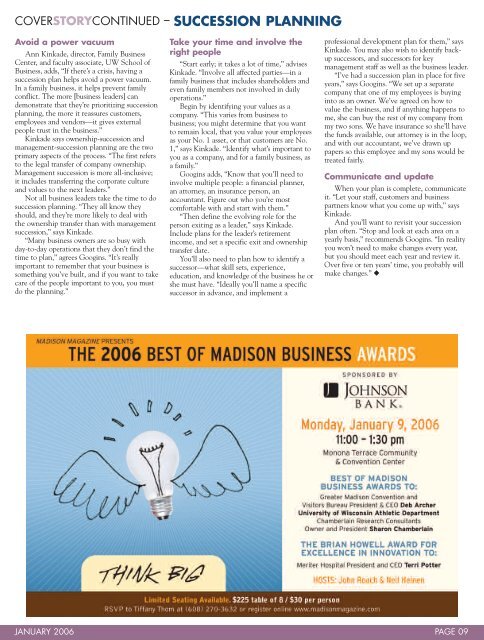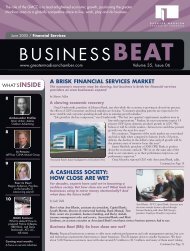January - Madison Magazine
January - Madison Magazine
January - Madison Magazine
Create successful ePaper yourself
Turn your PDF publications into a flip-book with our unique Google optimized e-Paper software.
COVERSTORYCONTINUED – SUCCESSION PLANNING<br />
Avoid a power vacuum<br />
Ann Kinkade, director, Family Business<br />
Center, and faculty associate, UW School of<br />
Business, adds, “If there’s a crisis, having a<br />
succession plan helps avoid a power vacuum.<br />
In a family business, it helps prevent family<br />
conflict. The more [business leaders] can<br />
demonstrate that they’re prioritizing succession<br />
planning, the more it reassures customers,<br />
employees and vendors—it gives external<br />
people trust in the business.”<br />
Kinkade says ownership-succession and<br />
management-succession planning are the two<br />
primary aspects of the process. “The first refers<br />
to the legal transfer of company ownership.<br />
Management succession is more all-inclusive;<br />
it includes transferring the corporate culture<br />
and values to the next leaders.”<br />
Not all business leaders take the time to do<br />
succession planning. “They all know they<br />
should, and they’re more likely to deal with<br />
the ownership transfer than with management<br />
succession,” says Kinkade.<br />
“Many business owners are so busy with<br />
day-to-day operations that they don’t find the<br />
time to plan,” agrees Googins. “It’s really<br />
important to remember that your business is<br />
something you’ve built, and if you want to take<br />
care of the people important to you, you must<br />
do the planning.”<br />
Take your time and involve the<br />
right people<br />
“Start early; it takes a lot of time,” advises<br />
Kinkade. “Involve all affected parties—in a<br />
family business that includes shareholders and<br />
even family members not involved in daily<br />
operations.”<br />
Begin by identifying your values as a<br />
company. “This varies from business to<br />
business; you might determine that you want<br />
to remain local, that you value your employees<br />
as your No. 1 asset, or that customers are No.<br />
1,” says Kinkade. “Identify what’s important to<br />
you as a company, and for a family business, as<br />
a family.”<br />
Googins adds, “Know that you’ll need to<br />
involve multiple people: a financial planner,<br />
an attorney, an insurance person, an<br />
accountant. Figure out who you’re most<br />
comfortable with and start with them.”<br />
“Then define the evolving role for the<br />
person exiting as a leader,” says Kinkade.<br />
Include plans for the leader’s retirement<br />
income, and set a specific exit and ownership<br />
transfer date.<br />
You’ll also need to plan how to identify a<br />
successor—what skill sets, experience,<br />
education, and knowledge of the business he or<br />
she must have. “Ideally you’ll name a specific<br />
successor in advance, and implement a<br />
professional development plan for them,” says<br />
Kinkade. You may also wish to identify backup<br />
successors, and successors for key<br />
management staff as well as the business leader.<br />
“I’ve had a succession plan in place for five<br />
years,” says Googins. “We set up a separate<br />
company that one of my employees is buying<br />
into as an owner. We’ve agreed on how to<br />
value the business, and if anything happens to<br />
me, she can buy the rest of my company from<br />
my two sons. We have insurance so she’ll have<br />
the funds available, our attorney is in the loop,<br />
and with our accountant, we’ve drawn up<br />
papers so this employee and my sons would be<br />
treated fairly.<br />
Communicate and update<br />
When your plan is complete, communicate<br />
it. “Let your staff, customers and business<br />
partners know what you come up with,” says<br />
Kinkade.<br />
And you’ll want to revisit your succession<br />
plan often. “Stop and look at each area on a<br />
yearly basis,” recommends Googins. “In reality<br />
you won’t need to make changes every year,<br />
but you should meet each year and review it.<br />
Over five or ten years’ time, you probably will<br />
make changes.” ◆<br />
JANUARY 2006 PAGE 09
















